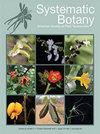Cecropia的分子系统学、物种概念和Myrmophysm(Cecropieae:荨麻科):限制性位点相关DNA的见解
IF 0.8
3区 生物学
Q4 EVOLUTIONARY BIOLOGY
引用次数: 0
摘要
摘要Cecropia是一组快速生长的先锋树,在森林再生中具有重要意义,是新热带地区常见的蚂蚁-植物互惠共生现象。为了研究Cecropia和相关蚂蚁之间互惠共生的进化,有必要建立一个系统发育框架。Cecropia物种在形态学上很难区分,传统的遗传标记也不足以解决物种之间的系统发育关系。我们的研究旨在将限制性位点相关DNA(RAD)测序的系统发育效用与先前基于常见测序基因区域的工作进行比较。RAD序列数据比以前的研究更好地解决和支持了物种水平的关系。我们确定了一个分歧很大的非桃金娘属分支,包括C.sciadophylla和African Musanga。来自地理广泛和形态异质的钝叶C.和狭叶C.的结果表明,当前的同义词具有集中的系统发育分化谱系。在高度支持的Cecropia系统发育学上重建蚂蚁联想推断Cecropias的祖先是否为myrmopophytic的概率相等。需要更深入的遗传学研究来完善Cecropia的物种概念。本文章由计算机程序翻译,如有差异,请以英文原文为准。
Molecular Systematics, Species Concepts, and Myrmecophytism in Cecropia (Cecropieae: Urticaceae): Insights from Restriction-Site Associated DNA
Abstract Cecropia is a group of fast-growing pioneer trees that are important in forest regeneration and a common ant-plant mutualism in the Neotropics. To investigate the evolution of mutualism between Cecropia and associated ants, a phylogenetic framework is necessary. Cecropia species are difficult to distinguish morphologically and conventional genetic markers are insufficiently variable to resolve the phylogenetic relationships among species. Our study aimed to compare the phylogenetic utility of restriction site associated DNA (RAD) sequencing to prior work based on commonly sequenced gene regions. RAD sequence data resolved and supported species-level relationships better than previous studies. We identified a deeply divergent non-myrmecophytic clade including C. sciadophylla and African Musanga. Results from geographically widespread and morphologically heterogenous C. obtusifolia and C. angustifolia suggest that current synonymy has lumped phylogenetically divergent lineages. Reconstruction of ant associations on the highly supported Cecropia phylogeny inferred equal probability of the ancestor of Cecropia being myrmecophytic or not. More intensive genetic study is needed to refine species concepts in Cecropia.
求助全文
通过发布文献求助,成功后即可免费获取论文全文。
去求助
来源期刊

Systematic Botany
生物-进化生物学
CiteScore
1.80
自引率
10.00%
发文量
72
审稿时长
6-12 weeks
期刊介绍:
Systematic Botany Monographs is a series of peer-reviewed taxonomic monographs and revisions published the American Society of Plant Taxonomists. ISSN 0737-8211, ISBN prefix 978-0-912861. No; volumes of Systematic Botany Monographs must be ordered separately. ASPT membership inludes only a subscription to the quarterly journal Systematic Botany. SBM is supported by sales, author"s subsidies, and donations.
 求助内容:
求助内容: 应助结果提醒方式:
应助结果提醒方式:


